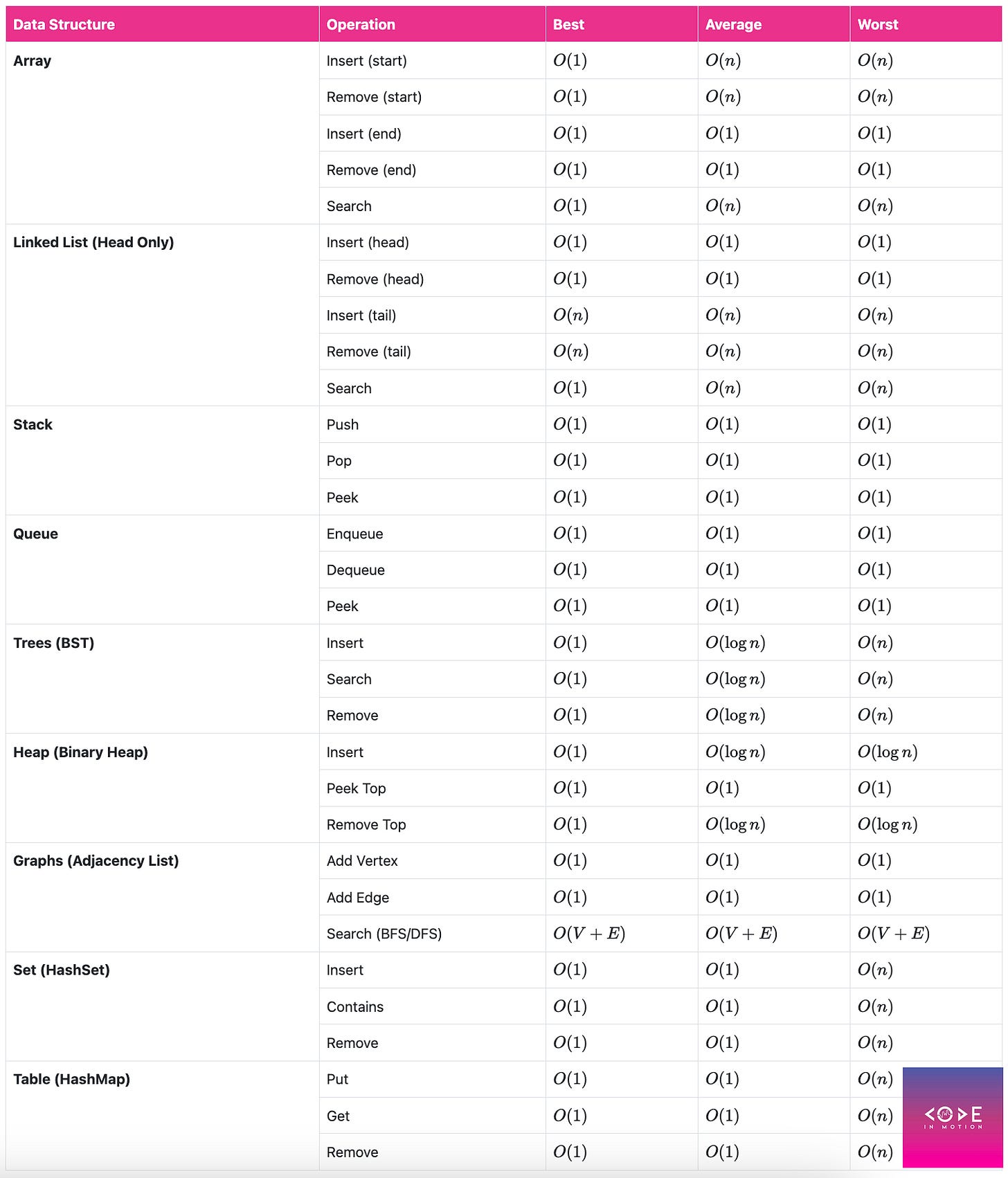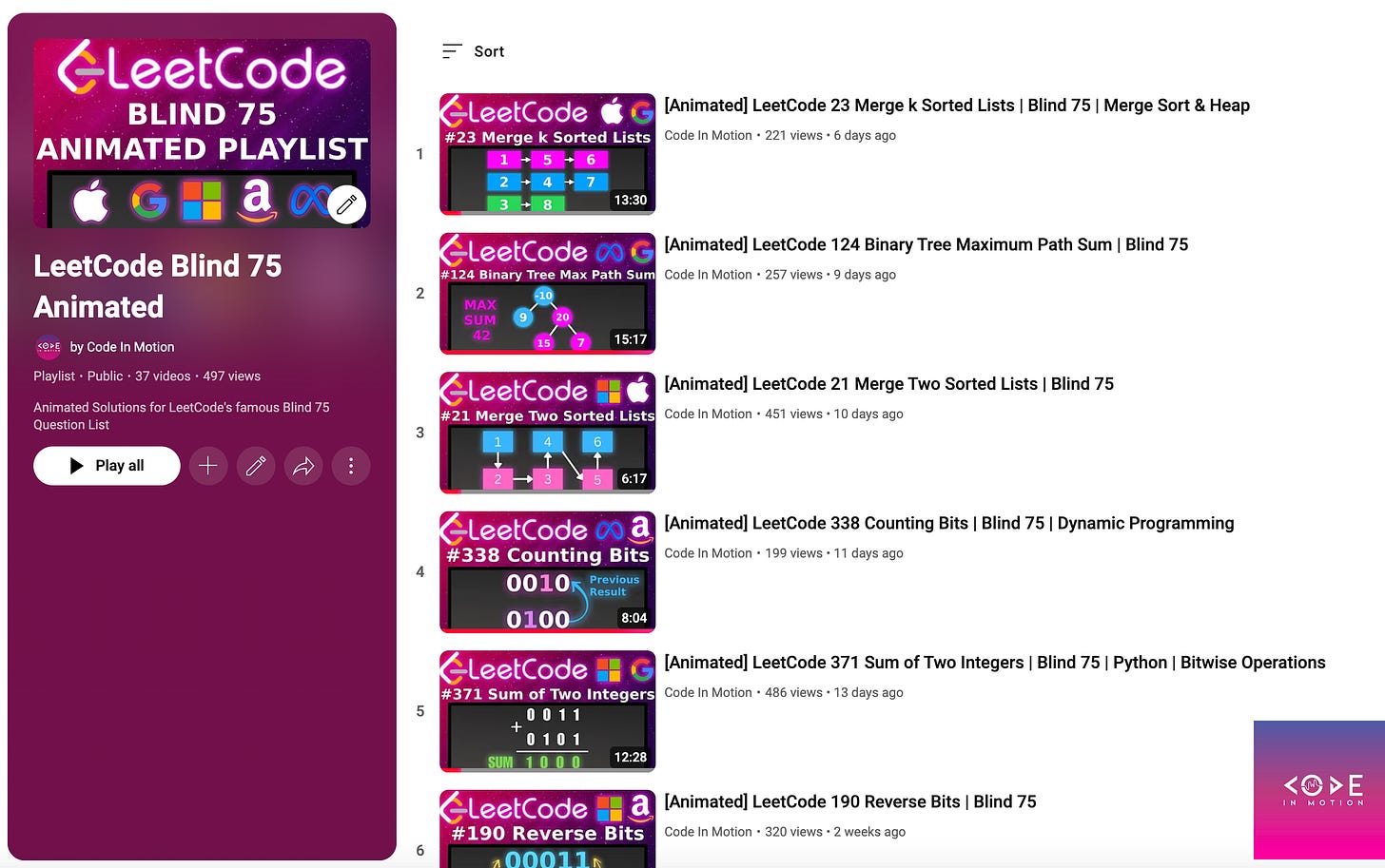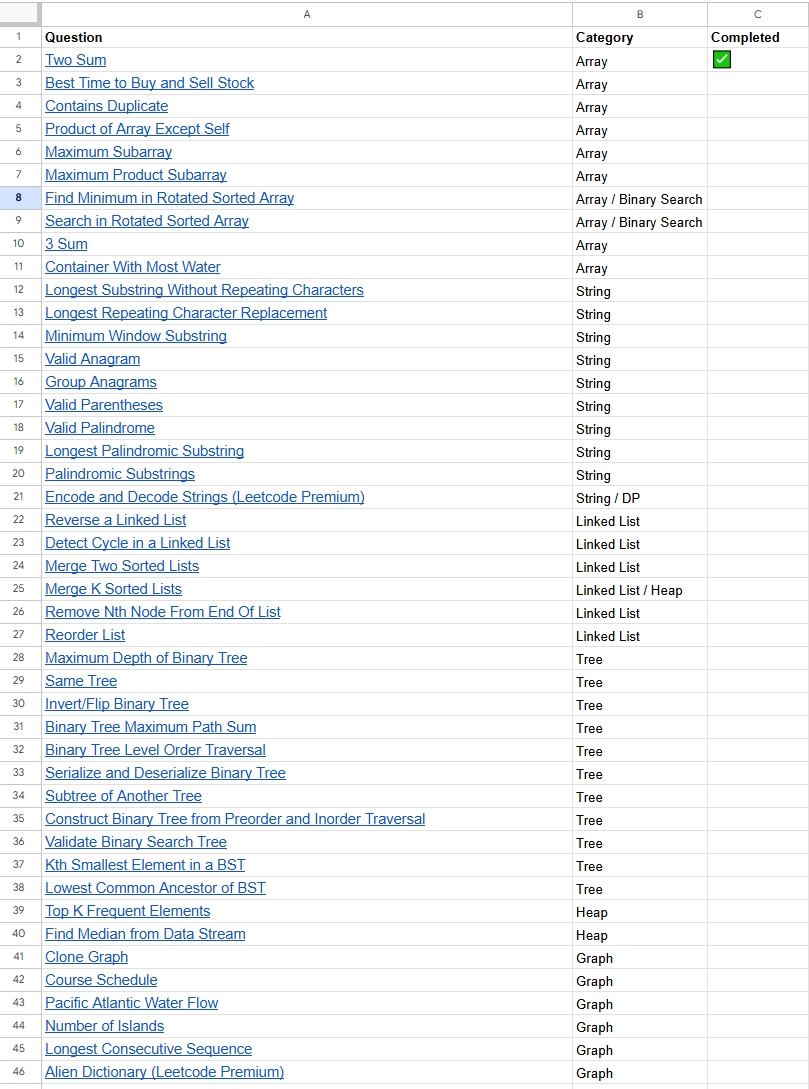How to start LeetCode in 2025
Master LeetCode with this step by step tutorial and start acing your tech interviews!
Learn how to study LeetCode effectively so that you stop memorizing hundreds of solutions and instead learn techniques to solve any problem.
1. Data Structures Overview
Before you begin LeetCode, you must know the common data structures and the time complexities associated with their operations.
You don’t need to know how to implement every data structure from scratch; however, you need to know the time complexities associated with their operations. Note that the best case time complexities are not that interesting and are provided for completeness. The more interesting time complexities are the average and worst case ones.
Many people don’t realize that Binary Trees have worst case time complexities of O(N) in the case of skewed trees. If you can mention that O(Log(N)) is for the average case for Trees in your interview, you will score bonus points for extra analysis.
Furthermore, many believe that sets and hashmaps have O(1) complexities, but this is for the average case. The worst case complexity is O(N) for these data structures. In LeetCode, we generally assume trees are O(Log(N)) and sets/maps are O(1), but it is important to understand these are for the average cases.
2. Learn Python
Python is the easiest language to LeetCode in because of its rich standard library and concise syntax, reducing the total lines of code for a solution.
If you already know Python, you can skip this section. However, if you’re trying to LeetCode in Java, JavaScript, C++, C#, or Go, I would highly recommend you invest 1 day to learn Python instead.
Python Benefits in LeetCode
Concise and Readable Syntax
Python reads like pseudo-code, making it easy to read and write code
Reduces boilerplate, allowing you to focus on implementing algorithms
Rich Standard Library
Provides powerful data structures like lists, dictionaries, sets, tuples, heaps, out of the box for free
Dynamic Typing and Flexibility
Facilitates easier manipulation of complex data structures and dynamic data handling.
Extensive Support for Common Algorithms
Built-in functions like
sorted(),bisect, andmapsimplify sorting, searching, and functional operations.
Is Learning Python Worth it?
Absolutely! Aside from LeetCode, Python is used for Data Science, Machine Learning, Backend Development, Web Development, Scripting, and many more use-cases! Learning Python for LeetCode is just one benefit of the world’s fastest growing language. You can never go wrong knowing Python. For this reason, I believe it is well worth the 1 day investment to learn it for LeetCode, since it will make interviewing much easier for you and add to your programming skillset!
How to Learn Python In 1 Day?
You can find many resources on Google and YouTube, but I actually recommend going through the following chapters in Python Tutorial Documentation.
Whetting Your Appetite
Using the Python Interpreter
An Informal Introduction to Python
More Control Flow Tools
Data Structures
Classes
Once you familiarize yourself with Python’s basic syntax and data structures, you will be well equipped to start using it for LeetCode!
3. Learn LeetCode Patterns
You should start your LeetCode journey by studying common LeetCode Patterns that will help you solve large amounts of problems.
14 LeetCode Patterns to Solve Any Question
If you prefer to watch this in video format with animations, watch it below!
People’s first mistake is jumping right into LeetCode and solving hundreds of questions without a clear plan or goal. This is an extremely inefficient way to study, since you’ll be memorizing solutions to problems instead of learning while investing hundreds of hours.
I have an entire blog post and YouTube video going over all of the LeetCode patterns you need to know with animations, coding templates, and LeetCode practice problems for free!
Focus on learning and understanding all of these patterns that will help you solve hundreds of LeetCode questions. After learning all of the LeetCode patterns, you will have a strong foundation to solve nearly any LeetCode question asked on your interview.
4. Framework to Approach any LeetCode Problem
Now that you’re familiar with LeetCode patterns, the next skill you need to learn is when to use a specific pattern for a specific problem
If you’ve followed my blog for all LeetCode Patterns, there are sections that explain when to use specific patterns. However, when you’re studying a specific pattern it’s easy to know you have to use that pattern for the current practice problem you’re solving. The real trick is to know when to use the pattern when it does not seem obvious to you.
You need a mental framework to approach any LeetCode problem.
Read the Problem Carefully
Underline key phrases or constraints
Example: "Find the longest substring" → Sliding Window
Analyze Input, Outputs, Constraints
Are there edge cases? (Empty input, negative values, duplicates)
Are there constraints? (1 ≤ n ≤ 10^5 → hints at O(n log n) or O(n) solutions)
Recognize the Problem Type
Use the decision matrix table to understand what keywords map to specific patterns you should consider
Optimize the Solution
Once you understand which pattern and data structures you should use, ask yourself if you can optimize your algorithm.
Are you scanning an internal data structure constantly? Can you use a hashmap to reduce the search from O(N) to O(1)?
Are you using an array to store previous results for dynamic programming? Can you use variables instead to reduce space from O(N) to O(1)?
Code the Solution
Its now time to code out your algorithm and verify it passes normal cases and edge cases successfully.
Treat code that you write during your interview as production-level code. This shows your interviewer good practices, but also helps them understand your solution. Use descriptive variable names.
5. Blind 75 Problem Set
After you’ve mastered your data structures, LeetCode patterns, and decision framework, it is time to put your skills to the test!
The Blind 75 is a famous set of 75 LeetCode questions that cover many topics and will give you broad exposure to data structures, algorithms, and patterns to use during your coding interviews.
You will now be solving the remainder of the Blind 75 problem set. I have extremely high quality, animated solutions for the Blind 75 set on my YouTube channel for FREE, so be sure to check them out to help you study!
I’ve also created a template tracker you can clone to keep track of your progress. You can hide the category column if you want to approach these problems in a random order, or tackle section by section to improve in a specific topic.
I highly recommend studying Dynamic Programming as your last topic since DP does not get asked by every company. Google is one of the few companies that still ask DP, but many such as Meta have gotten rid of it. Therefore, I suggest you follow the order of questions mentioned in the Blind 75 Template as the later topics have diminishing returns. Focus on Arrays/Strings/Linked Lists/Trees/Heaps/Graphs which have a high probability of getting asked.
6. Final Tips
Even though studying for tech interviews is stressful, if you are miserable throughout the process you won’t learn effectively. Try to approach problems with curiosity and problem-solving which can help motivate you to study and maybe even have some fun as you start getting the questions right!
Wishing you the best of luck on your journey to get into your dream company and FAANG! Feel free to subscribe to my blog for more premium quality content for FREE!







I was started to solve the leetcode problem, but i can not understand how to solve them and then i watched YT tutorial videos and understand. Then after few days pass i cannot memorize them. And then again the same things. Thank You so much for the valuable instruction . Now i will try to learn this pattern first then i solve and solve the same pattern problelm so that i can insure that i understand them and if i face the same type of problem next then i can solve them.
Nice article loved it.